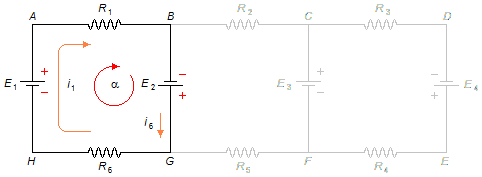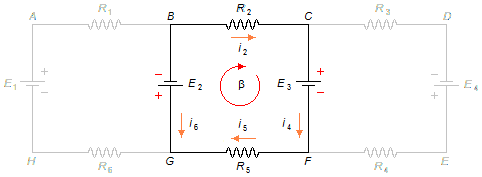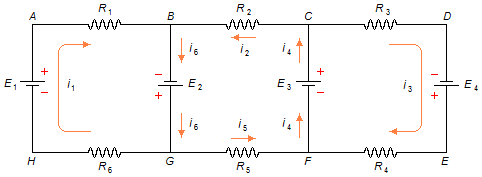Solved Problem on Kirchhoff's Laws
advertisement
In the circuit below find the currents in the branches and their directions.

Problem data:
Resistors:
- R1 = 1 Ω;
- R2 = 2 Ω;
- R3 = 1 Ω;
- R4 = 2 Ω;
- R5 = 1 Ω;
- R6 = 2 Ω;
- E1 = 10 V;
- E2 = 20 V;
- E3 = 10 V;
- E4 = 20 V;
First, to each branch of the circuit, we arbitrarily choose a direction of the current. In the branch GHAB we have the current i1 clockwise, in the branch BC the current i2 going from B to C, in the branch CDEF the current i3 clockwise, in the branch CF the current i4 going from C to F, in the branch FG the current i5 going from F to G, and in the branch BG the current i6 going from B to G. Second for each loop of the circuit we assign a direction, also random, to traverse the loop. α-mesh (GHABG), β-mesh (BCFGB), and γ-mesh (CDEFC) all clockwise (Figure 1).

- Applying Kirchhoff's First Law
\[
\begin{gather}
\bbox[#99CCFF,10px]
{\sum_{n} i_{n}=0}
\end{gather}
\]
The current i1 flows into node B, and the currents i2 and
i6 flow out
\[
\begin{gather}
i_{1}=i_{2}+i_{6} \tag{I}
\end{gather}
\]
The current i2 reaches node C, and the currents i3 and
i4 flow out
\[
\begin{gather}
i_{2}=i_{3}+i_{4} \tag{II}
\end{gather}
\]
The currents i3 and i4 reach node F, and the current
i5 flows out
\[
\begin{gather}
i_{5}=i_{3}+i_{4} \tag{III}
\end{gather}
\]
- Applying Kirchhoff's Second Law
\[
\begin{gather}
\bbox[#99CCFF,10px]
{\sum_{n} V_{n}=0}
\end{gather}
\]
For the α-mesh from point A in the chosen direction, forgetting the meshes β and γ
(Figure 2)

\[
\begin{gather}
R_{1}i_{1}-E_{2}+R_{6}i_{1}-E_{1}=0
\end{gather}
\]
substituting the problem values
\[
\begin{gather}
1i_{1}-20+2i_{1}-10=0\\[5pt]
3i_{1}-30=0\\3i_{1}=30\\[5pt]
i_{1}=\frac{30}{3}\\[5pt]
i_{1}=10\;\text{A}
\end{gather}
\]
For the β-mesh from point B in the chosen direction, forgetting the meshes α and γ
(Figure 3)

\[
\begin{gather}
R_{2}i_{2}+E_{3}+R_{5}i_{5}+E_{2}=0
\end{gather}
\]
substituting the values
\[
\begin{gather}
2i_{2}+10+1i_{5}+20=0\\[5pt]
2i_{2}+i_{5}+30=0 \\[5pt]
2i_{2}+i_{5}=-30 \tag{IV}
\end{gather}
\]
For the γ-mesh from point C in the chosen direction, forgetting the meshes α and β
(Figure 4)

\[
\begin{gather}
R_{3}i_{3}-E_{4}+R_{4}i_{3}-E_{3}=0
\end{gather}
\]
substituting the values
\[
\begin{gather}
1i_{3}-20+2i_{3}-10=0\\[5pt]
i_{3}+2i_{3}-30=0\\[5pt]
3i_{3}=30\\[5pt]
i_{3}=\frac{30}{3}\\[5pt]
i_{3}=10\;\text{A}
\end{gather}
\]
Substituting the values of i1 and i3 in (I), (II) and (III), we have the
equations (I), (II), (III) and (IV) as a system of four equations with four unknowns (i2,
i4, i5, and i6)
\[
\left\{
\begin{array}{l}
\;i_{2}+i_{6}=10\\
\;i_{2}-i_{4}=10\\
\;i_{5}-i_{4}=10\\
\;2i_{2}+i_{5}=-30
\end{array}
\right.
\]
factoring i4 in the second equation
\[
\begin{gather}
i_{4}=i_{2}-10 \tag{V}
\end{gather}
\]
substituting the expression (V) in the third equation
\[
\begin{gather}
i_{5}-(i_{2}-10)=10\\[5pt]
i_{5}-i_{2}+10=10 \\[5pt]
i_{5}-i_{2}=10-10 \\[5pt]
i_{5}-i_{2}=0 \\[5pt]
i_{5}=i_{2} \tag{VI}
\end{gather}
\]
substituting the expression (VI) in the fourth equation
\[
\begin{gather}
2i_{2}+i_{2}=-30\\[5pt]
3i_{2}=-30\\[5pt]
i_{2}=\frac{-{30}}{3}\\[5pt]
i_{2}=-10\ \text{A}
\end{gather}
\]
The expression (VI) gives
\[
\begin{gather}
i_{5}=-10\ \text{A}
\end{gather}
\]
Substituting the value of i2 in expression (V)
\[
\begin{gather}
i_{4}=-10-10\\[5pt]
i_{4}=-20\ \text{A}
\end{gather}
\]
Substituting the value of i2 in the first equation
\[
\begin{gather}
-10+i_{6}=10\\[5pt]
i_{6}=10+10\\[5pt]
i_{6}=20\ \text{A}
\end{gather}
\]
Since the values of the currents i2, i4 and i5 are
negative, their real directions are contrary to those chosen in Figure 1. The values of currents are
i1=10 A,
i2=10 A,
i3=10 A,
i4=20 A,
i5=10 A,
and
i6=20 A
and their directions are shown in Figure 5.

advertisement

Fisicaexe - Physics Solved Problems by Elcio Brandani Mondadori is licensed under a Creative Commons Attribution-NonCommercial-ShareAlike 4.0 International License .